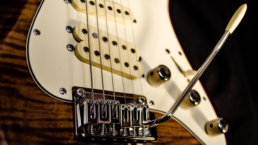Different Types of Electric Guitar Pickups
It’s fairly obvious that the key difference between acoustic guitars and electric guitars is in the name. Electric guitars rely on electromagnetic guitar pickups to produce sound, while acoustic guitars rely on physical acoustic projection to amplify their strings. But, how exactly do guitar pickups work? And why do different ones sound different?
For starters, let’s answer that first question. Put as simply as possible, guitar pickups are electromagnetic sensors that translate the vibrations from magnetic strings into a signal that can be amplified and played through a speaker. But when translating signals into sound, there are some undesirable artifacts that can emerge. The most notable of these artifacts are humming noises that come from electromagnetic interference. So, over the years, pickup makers invented some clever workarounds that resulted in some new tonal signatures (some of which we’re all quite fond)! So, let’s take a look at the different types of pickups and what they’re good for!
As with guitar tonewoods, it’s important to note that there is not one best type of guitar pickup. It’s all about preference and what tones you are trying to achieve. There are many different variations of guitar pickups. But today, we’ll be looking at the three most basic types.
 1. Single Coil Pickups
1. Single Coil Pickups
Derived from the original “horseshoe” pickup first invented in the mid 1930s, the single-coil guitar pickup is the most basic of the standard guitar pickups. Its construction consists of permanent magnetic poles (one for each string) that are fixed between bobbin plates. The poles are then wound with copper wire, and is referred to as the “coil.” The magnetic poles generate a magnetic field. Then when a guitar’s strings vibrate, they disrupt the magnetic field. The coil then translates these magnetic disruptions into an electrical current, which travels through an instrument cable to an amplifier, which boosts the sound before it plays through a speaker.
Of the pickups we’re covering here, single coil pickups generally sound the brightest, and handle clean boosting quite well. Conversely, they tend to do a little less well with high levels of distortion. These pickups are famously included in most Fender Stratocasters and Telecasters, and are popularly associated with surf and country music. In fact, you can see a single coil pickup in a Stratocaster in the image at the top of this article (it’s the pickup at the top of the image). One of the big drawbacks of single coil pickups, however, is that they are VERY good at picking up ambient signals like radio waves, fields from household electrical appliances, and 60-cycle hum from your power source. This issue was largely solved by the inventor of the next pickup on our list. Let’s check it out!
 2. Humbucker Pickups
2. Humbucker Pickups
In the 1950s, we saw the emergence of humbucking pickups in electric guitars. These ingenious additions essentially consist of two coils with opposite polarity that sit parallel to each other, and are wound in opposite directions. The result is that interference that causes hum is greatly reduced, and you have less noisy signal. But that’s not all. Humbuckers have a unique tone unto themselves.
Popularized by Gibson and their Les Paul model, humbuckers carry a lot more mid range than single coils. They also lack the high end that’s present in a single coil tone. So, these pickups handle high levels of distortion with ease, and are often preferred by guitarists playing rock and metal music. On the other hand, they can lean toward sounding muddy when played with a clean signal. One exception to this, however, is their use in jazz guitar music, where they are generally preferred for their fidelity and mellow tone.
 3. P-90 Pickups
3. P-90 Pickups
If you are wondering to yourself, “why isn’t there a pickup that perfectly strikes the balance between single coil and humbucking pickups?” then let us introduce the P-90 pickup! Though they are technically still a “single coil” pickup, the coils are wound onto a wider bobbin that keep the wire further from the magnetic poles. Thus, this pickup retains some of the brightness of a single coil, but also shares some warmth with humbuckers. P-90s can also withstand more distortion than single coils, but still sound great when running through a clean channel.
P-90s were developed by Gibson as an alternative to their Charlie Christian pickup (that was popularly associated with their ES-150). These pickups are not just for jazz, however. Because of their tonal balance, they are extremely versatile and are often used in rock, blues, and country amongst other styles.
Excited to look at some new pickups for your guitar? Find all kinds of great guitar gear deals over at Sweetwater.com.
JamPlay has over 450 guitar courses from 120+ instructors, LIVE daily instruction, and online guitar lessons tailored to every skill level, music genre, and playing style. Click here to learn more.
Share this
Become a JamPlay member for unlimited access to 7000+ guitar lessons and 120+ artists and instructors. View membership plans ›



